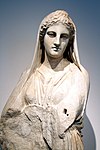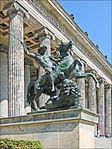Aphrodite Heyl
2nd-century BC sculpturesAeolian dodecapolisClassical sculptures of the Berlin State MuseumsSculptures of VenusSculptures of women in Germany ... and 2 more
Statues in GermanyTerracotta sculptures in Germany
The statuette of Aphrodite known as Aphrodite Heyl in the Antikensammlung Berlin (inventory number 31272) is an especially finely worked terracotta statue from the second century BC.
Excerpt from the Wikipedia article Aphrodite Heyl (License: CC BY-SA 3.0, Authors).Aphrodite Heyl
Am Lustgarten, Berlin Mitte
Geographical coordinates (GPS) Address Phone number Website Nearby Places Show on map
Geographical coordinates (GPS)
| Latitude | Longitude |
|---|---|
| N 52.5194 ° | E 13.3983 ° |
Address
Altes Museum
Am Lustgarten
10178 Berlin, Mitte
Germany
Open on Google Maps










